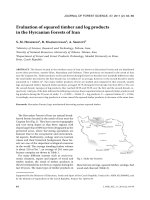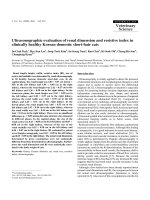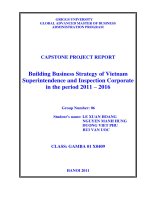Evaluation of the antioxidant activity of scutellaria baicalensis and its constituents in diabetic rats
Bạn đang xem bản rút gọn của tài liệu. Xem và tải ngay bản đầy đủ của tài liệu tại đây (6.08 MB, 174 trang )
EVALUATION OF THE ANTIOXIDANT ACTIVITY OF
SCUTELLARIA BAICALENSIS AND ITS
CONSTITUENTS IN DIABETIC RATS
VIDURANGA YASHASVI WAISUNDARA
(B.Sc, Hons), NUS
A THESIS SUBMITTED FOR THE DEGREE OF DOCTOR OF
PHILOSOPHY
DEPARTMENT OF CHEMISTRY
NATIONAL UNIVERSITY OF SINGAPORE
2010
2
ACKNOWLEDGEMENTS
First, the author would like to thank the supervisor of this project, Assistant Professor
Huang Dejian and co-supervisor Associate Professor Benny Kwong-Huat Tan for providing the
guidance, support and courage to facilitate the completion of the research work.
Next, the author wishes to appreciate the assistance rendered by senior lab technologists
Miss Annie Hsu and Miss Lee Chooi Lan as well as lab technologist Miss Lew Huey Lee.
Then, the author wishes to express her gratitude to Professor Bay Boon Huat of the
Department of Anatomy, Yong Loo Lin School of Medicine and Associate Professor Heng Chew
Kiat of the Department of Pediatrics, Yong Loo Lin School of Medicine for providing guidance
with histological and microarray analysis during the in vivo studies.
The author also appreciates the involvements by the undergraduate students who
contributed to certain portions of the project, Miss Huang Meiqi, Miss Neo Yining, Mr Sin Wei
Xiang, Miss Siu Sing Yung and Miss Bay Wan Ping.
Last but not least, the author wishes to express her gratefulness to her parents, husband,
grandparents, relatives and friends for providing the moral support and courage to pursue the
research work.
For every Ph.D, there is an equal and opposite Ph.D – Gibson’s Law
3
TABLE OF CONTENTS
ACKNOWLEDGEMENTS 2
SUMMARY 6
LIST OF TABLES 7
LIST OF FIGURES 8
LIST OF ABBREVIATIONS 17
LIST OF PUBLICATIONS AND CONFERENCE PAPERS 21
CHAPTER 1 INTRODUCTION 25
1.1 Background 26
1.2 Objectives 29
References 30
CHAPTER 2 LITERATURE REVIEW 33
2.1 A brief history of diabetes mellitus 34
2.2 The causes of diabetes mellitus and its complications 36
2.3 The issues on current treatments for diabetes mellitus 41
2.4 Traditional Chinese Medicine in the prevention of diabetes mellitus-induced
oxidative stress and its complications 47
2.5 In vivo models of diabetes 52
References 55
4
CHAPTER 3 CHARACTERIZATION OF THE ANTIOXIDANT AND ANTI-
DIABETIC ACTIVITIES OF SCUTELLARIA BAICALENSIS IN STREPTOZOTOCIN-
INDUCED DIABETIC WISTAR RATS 63
Abstract 64
3.1 Introduction 65
3.2 Materials & methods 66
3.3 Results 75
3.4 Discussion 87
References 91
CHAPTER 4 BAICALIN MEDIATED ANTI-DIABETIC EFFECT ON
STREPTOZOTOCIN-INDUCED DIABETIC WISTAR RATS IS ASSOCIATED WITH AN
ENHANCED ANTIOXIDANT EFFECT 95
Abstract 96
4.1 Introduction 97
4.2 Materials & methods 98
4.3 Results 101
4.4 Discussion 112
References 115
5
CHAPTER 5 BAICALIN REDUCES MITOCHONDRIAL DAMAGE IN
STREPTOZOTOCIN-INDUCED DIABETIC WISTAR RATS 117
Abstract 118
5.1 Introduction 119
5.2 Materials & methods 120
5.3 Results 121
5.4 Discussion 127
References 131
CHAPTER 6 BAICALIN UPREGULATES THE GENETIC EXPRESSION OF
ANTIOXIDANT ENZYMES IN TYPE-2 DIABETIC GOTO-KAKIZAKI RATS
Abstract 135
6.1 Introduction 136
6.2 Materials & methods 137
6.3 Results 137
6.4 Discussion 156
References 160
CHAPTER 7 CONCLUSIONS 163
Appendix 166
6
SUMMARY
Scutellaria baicalensis is a commonly used herb in Traditional Chinese Medicine to treat
diabetes and its complications owing to its potent antioxidant and radical scavenging activities.
Many of the diabetic micro- and macrovascular complications are known to arise due to free
radical-induced oxidative stress and reduced intrinsic antioxidant defenses. Thus, the preliminary
research work involved the characterization of antioxidant mechanisms of Scutellaria baicalensis
in type 1 diabetic Wistar rat models. Its bioactive flavonoid compounds were screened for radical
scavenging potential in an in vitro cell culture model of hyperglycemia. Thereby, baicalin was
identified as the primary bioactive compound in the herbal extract. The antioxidant potential of
baicalin was further characterized in the STZ-induced diabetic Wistar rat model. The results
obtained from this study confirmed baicalin as the primary bioactive compound in Scutellaria
baicalensis in comparing and contrasting the data with the preliminary in vivo study. It was
observed that baicalin increased the antioxidant enzyme expression as well as reduced the
oxidative damage to the intracellular mitochondria. The antioxidant effects of baicalin were also
investigated in the type 2 diabetic Goto-Kakizaki rat model. The mechanisms of action were
similar to both animal models. In summary, the identification of baicalin as a potential
complementary therapeutic agent for diabetes to improve the anti-oxidant status and reduce
oxidative stress was the key discovery in this research work.
7
LIST OF TABLES
Table 2.1 Milestones and important years in the history of diabetes
Table 2.2 Classification of existing oral anti-diabetic treatments (Das and
Chakrabarthi, 2005)
Table 2.3 Medicines and natural products used in TCM in the treatment of Diabetes
(Li et. al., 2004)
Table 2.4 Chemical compounds in TCM medicines with anti-Diabetic activity (Yin
and Chen, 2000)
Table 3.1 Antioxidant enzyme activities of the treatment groups
Table 4.1 ORAC values of baicalein, baicalin and wogonin
8
LIST OF FIGURES
Figure 2.1 Production of superoxide by the ETC in the mitochondria (from Brownlee, 2005)
Figure 2.2 Activation of the four pathways leading to diabetic complications through
mitochondria superoxide production triggered through hyperglycemia
(Brownlee, 2005)
Figure 2.3 Structure of flavonoids. Dietary flavonoids are diverse and vary according to
hydroxylation pattern, conjugation between the aromatic rings, glycosidic
moieties, and methoxy groups. Polymerization of this nuclear structure yields
tannins and other complex species occurring in red wine, grapes and black tea
(Kotsuyak et. al., 2001)
Figure 2.4 Dried root of Scutellaria baicalensis
Figure 2.5 Chemical structures of the primary flavonoid constituents of Scutellaria
baicalensis (A) baicalin (B) baicalein (C) wogonin
Figure 2.6 Goto-Kakizaki rat model of type 2 DM
Figure 3.1 HPLC chromatograms of (A) phenolic compounds (B) sugars present in
the ethanolic extract of S. baicalensis. The major phenolic compound
(peak no. 1 in 1A) was identified as baicalin which comprised 29.6% of
the extract. The peaks on sugar analysis were identified as follows: 1.
Unknown compound 2. Stachyose 3. Raffinose 4. Sucrose 5. Glucose 6.
Galactose
9
Figure 3.2 Percentage plasma glucose level variations during the OGTT. Values are
expressed as mean ± SEM (Standard Error Mean). Each group includes 6
rats per treatment. * p < 0.05 versus the diabetic control; † p < 0.05 versus
the metformin-treated group
Figure 3.3 Effects of metformin, S. baicalensis and metformin + S. baicalensis on
(A) weekly blood glucose levels (B) plasma insulin concentration (C)
pancreatic insulin content in STZ-diabetic Wistar rats. Values are
expressed as mean ± SEM (Standard Error Mean). Each group includes 6
rats per treatment. * p < 0.05 versus the diabetic control; † p < 0.05 versus
the metformin-treated group
Figure. 3.4 Effects of metformin, S. baicalensis and metformin + S. baicalensis on
hepatic (A) catalase (CAT) activity (B) superoxide dismutase (SOD) activity (C)
glutathione peroxidase (GPx) activity (D) protein expression of CAT,
SOD and GPx in STZ-diabetic Wistar rats. The values were measured on
day 30 and are representative of 6 rats per group. Results are expressed as
mean ± SEM. * p < 0.05 versus the diabetic control; † p < 0.05 versus the
metformin-treated group
Figure 3.5 Effects of metformin, S. baicalensis and metformin + S. baicalensis on
(A) weekly plasma lipid peroxide concentrations (B) hepatic lipid
peroxide contents (C) kidney lipid peroxide contents (D) pancreatic lipid
peroxide contents in STZ-diabetic Wistar rats. The lipid peroxide contents
are expressed as mean ± SEM and represent the analysis of 6 rats per
10
group. * p < 0.05 versus the diabetic control; † p < 0.05 versus the
metformin-treated group
Figure 3.6 Effects of metformin, S. baicalensis and metformin + S. baicalensis on (A)
plasma TG (B) plasma total cholesterol TC (C) hepatic TG (D) hepatic TC in
STZ-diabetic Wistar rats. Values are expressed as mean ± SEM (Standard Error
Mean). Each group includes 6 rats per treatment. * p < 0.05 versus the diabetic
control; † p < 0.05 versus the metformin-treated group
Figure. 3.7 Effects of the treatments on hepatic lipase activity in STZ-diabetic Wistar
rats. The enzyme activities are expressed as mean ± SEM and represent
the analysis of 6 rats per group. * p < 0.05 versus the diabetic control; †
p < 0.05 versus the metformin-treated group
Figure 3.8 Histology of the kidney in STZ-diabetic Wistar rats. The images were
taken under x100 magnification with H & E staining. Observation of the
kidney sections did not indicate renal pathology in any of the treatment
groups. Scale bars indicate 750µm
Figure 3.9 Histology of the liver in STZ-diabetic Wistar rats. The images were taken
under x100 magnification with H & E staining. Observation of liver
sections did not show any signs of hepatic deterioration in any of the
treatment groups. Scale bars indicate 750µm
Figure 3.10 Histology of the pancreas in STZ-diabetic Wistar rats. The images were
taken under x400 magnification with haemotoxylin staining. The intact
Langerhan Islets explain the increase in plasma and pancreatic insulin
contents despite the administration of STZ. Scale bars indicate 100µm
11
Figure 4.1 The ROS contents in the HUVECs treated with the various dosages of
baicalin, baicalein and wogonin compounds. Values are expressed as
mean ± SEM. The average value per treatment group was calculated by 3
group cells. * p < 0.05 versus the glucose stressed control group
Figure 4.2 Effects of metformin, baicalin and metformin + baicalin on (A) daily
water intake; (B) daily food intake; and (C) plasma leptin content of STZ-
diabetic Wistar rats. Values are expressed as mean ± SEM (Standard Error
Mean). Each group includes 6 rats per treatment. * p < 0.05 versus the
diabetic control; † p < 0.05 versus the metformin-treated group
Figure 4.3 Effects of metformin, baicalin and metformin + baicalin on the hepatic (A) CAT
activity; (B) SOD activity; (C) GPx activity; (D) protein expression of CAT, SOD
and GPx; (E) representative Western Blot images of the protein expressions of
CAT, SOD and GPx in STZ-diabetic Wistar rats. The values were measured on
day 30 and are representative of 6 rats per group. Results are expressed as mean ±
SEM. * p < 0.05 versus the diabetic control; † p < 0.05 versus the metformin-
treated group.
Figure 4.4 Effects of metformin, baicalin and metformin + baicalin treatments of STZ-
diabetic Wistar rats on (A) weekly plasma lipid peroxide concentrations; (B)
hepatic lipid peroxide contents; (C) kidney lipid peroxide contents; (D) pancreatic
lipid peroxide contents The lipid peroxide contents are expressed as mean ± SEM
and represent the analysis of 6 rats per group. * p < 0.05 versus the diabetic
control; † p < 0.05 versus the metformin-treated group
12
Figure 4.5 Effects of metformin, baicalin and metformin + baicalin on (A) weekly blood
glucose levels; (B) weekly plasma insulin concentration; and (C) pancreatic
insulin content in STZ-diabetic Wistar rats. Values are expressed as mean ± SEM.
Each group includes 6 rats per treatment. * p < 0.05 versus the diabetic control; †
p < 0.05 versus the metformin-treated group
Figure 4.6 Effects of metformin, baicalin, and metformin + baicalin on (A) weekly plasma
TG concentrations; (B) weekly plasma TC concentrations; (C) hepatic TG; (D)
hepatic TC; (E) hepatic lipase activity in STZ-diabetic Wistar rats. Values are
expressed as mean ± SEM. Each group includes 6 rats per treatment. * p < 0.05
versus the diabetic control; † p < 0.05 versus the metformin-treated group.
Figure 4.7 Effects of metformin, baicalin and metformin + baicalin on (A) hepatic glycogen
contents; (B) hepatic glycogen synthase activity; (C) hepatic glucose-6-
phosphatase activity in STZ-diabetic Wistar rats. Values are expressed as mean ±
SEM. Each group includes 6 rats per treatment. * p < 0.05 versus the diabetic
control; † p < 0.05 versus the metformin-treated group
Figure 5.1 TEM images of the mitochondrial pathology in the pancreatic β-cells of
the vehicle-treated (DC) metformin-treated (M), baicalin-treated (B) and
metformin + baicalin treated (MB) STZ-induced diabetic Wistar rats. The
scale bars indicate 0.5 µm and 0.2 µm for the image of the vehicle-treated
group. The circle indicates mitochondrial membranal damage in the
vehicle-treated group
13
Figure 5.2 TEM images of the mitochondrial pathology in the hepatocytes of the
vehicle-treated (DC) metformin-treated (M), baicalin-treated (B) and
metformin + baicalin treated (MB) STZ-induced diabetic Wistar rats. The
scale bars indicate 0.5 µm and 0.2 µm for the image of the vehicle-treated
group. The circle indicates mitochondrial membranal damage in the
vehicle-treated group
Figure 5.3 TEM images of the mitochondrial membrane pathology in the pancreatic
β-cells of the vehicle-treated (DC) metformin-treated (M), baicalin-treated
(B) and metformin + baicalin treated (MB) STZ-induced diabetic Wistar
rats. The scale bars indicate 0.1 µm. The circle indicates the damage to the
inner mitochondrial membrane in the vehicle- and metformin-treated
groups
Figure 5.4 Number of mitochondria with damaged membranes in the hepatocytes of
the various treatment groups. Values are expressed as mean ± SEM. Each
group includes 6 rats per treatment. * p < 0.05 versus the diabetic control,
† p < 0.05 versus the metformin-treated group
Figure 5.5 Effects of metformin, baicalin and metformin + baicalin on (A) the hepatic
mitochondrial number (B) hepatic citrate synthase activities and (C)
plasma leptin content of STZ-diabetic Wistar rats. Values are expressed as
mean ± SEM. Each group includes 6 rats per treatment. * p < 0.05 versus
the diabetic control; † p < 0.05 versus the metformin-treated group
14
Figure 6.1 Effects of metformin, baicalin and metformin + baicalin on the hepatic (A) SOD
activity; (B) CAT activity; (C) GPx activity; (D) quantifications of the protein
expressions of CAT, SOD and GPx in the GK rats; (E) representative western blot
image of CAT, SOD and GPx quantification. The values were measured on day
30 and are representative of 6 rats per group. Results are expressed as mean ±
SEM. * p < 0.05 versus the diabetic control; † p < 0.05 versus the metformin-
treated group.
Figure 6.2 Clustered display of microarray data of the antioxidant enzymes SOD1 (soluble)
SOD2 (mitochondrial), SOD3 (extracellular), CAT and GPx. The representative
colour scale for the respective FC levels is included in the top right corner of the
array display.
Figure 6.3 RT-PCR quantification of SOD1, SOD2, SOD3, CAT and GPx in correlation with
the microarray genetic expression. Results are expressed as mean ± SEM. * p <
0.05 versus the diabetic control; † p < 0.05 versus the metformin-treated group.
Figure 6.4 Effects of metformin, baicalin and metformin + baicalin treatments of STZ-
diabetic Wistar rats on (A) weekly plasma lipid peroxide concentrations and (B)
plasma protein carbonyl contents. Values are expressed as mean ± SEM and
represent the analysis of 6 rats per group. * p < 0.05 versus the diabetic control; †
p < 0.05 versus the metformin-treated group
15
Figure 6.5 TEM images of the mitochondrial membrane pathology in the pancreatic
β-cells of the vehicle-treated (DC) metformin-treated (M), baicalin-treated
(B) and metformin + baicalin treated (MB) GK rats. The scale bars
indicate 0.1 µm. The circle indicates the damage to the inner
mitochondrial membrane in the vehicle-treated group
Figure 6.6 Effects of metformin, baicalin and metformin + baicalin on (A) the hepatic
mitochondrial number (B) hepatic citrate synthase activities and (C) plasma leptin
content of GK rats. Values are expressed as mean ± SEM (Standard Error Mean).
Each group includes 6 rats per treatment. * p < 0.05 versus the diabetic control; †
p < 0.05 versus the metformin-treated group
Figure 6.7 Effects of metformin, baicalin and metformin + baicalin treatments of GK
rats on (A) weekly plasma glucose concentrations, (B) plasma insulin
content, (C) plasma TC contents and (D) plasma TG contents. The plasma
insulin, TC and TG contents were measured on day 30 of the treatment.
The values are expressed as mean ± SEM and represent the analysis of 6
rats per group. * p < 0.05 versus the diabetic control; † p < 0.05 versus the
metformin-treated group
Figure 6.8 Effects of metformin, baicalin and metformin + baicalin on (A) daily water
intake; and the (B) daily food intake in type 2 diabetic GK rats. Values are
expressed as mean ± SEM (Standard Error Mean). Each group includes 6 rats per
treatment. The food intake on the final day of the treatment corresponded with the
respective plasma leptin levels of the treatment groups. * p < 0.05 versus the
diabetic control; † p < 0.05 versus the metformin-treated group
16
Figure 6.9 Histology of the heart tissues type 2 diabetic GK rats. The images were
taken under x100 magnification with H & E staining. The red circles
indicate capillary wall thickening observed in groups DC and M. Scale
bars indicate 750µm
17
LIST OF ABBREVIATIONS
13(S)H pODE - 13(S)Hydroperoxy Octadecanoic Acid
ACCORD - Action to Control Cardiovascular Risk in Diabetes
ACE - Angiotensin-converting Enzyme inhibitor
AGE-products - Advanced-Glycation End products
ALT - Alanin Transaminase
AMPK - Adenosine Monophosphate-activated protein kinase
ANOVA - Analaysis of Variance
AST - Aspartate Transaminase
ATP - Adenosine Tris-Phosphate
BHT - Buytlated Hydroxy Toluene
CAT - Catalase
CMH
2
DCFDA- 5-(and-6)-chloromethyl-2’,7’-dichlorodihydro-fluorescein diacetate
COX - Cyclooxygenase
CRM - Calorie-Restriction Mimetics
CRP - C-Reactive Protein
DC - Diabetic Control
DCTT - Diabetes Control and Complications Trial
DI - Deionized
DM - Diabetes Mellitus
DPPH - 2,2-diphenyl-1-picryhydrazyl radical
ECL - Enhanced Chemiluminescence
18
EIA - Enzyme Immunoassay
ELISA - Enzyme Linked Immunosorbent Assay
eNOS - Endothelial Nitric Oxide Synthase
ESI-MS - Electron Spray Ionization – Mass Spectrometry
ETC - Electron Transport Chain
F-6-P - Fructose-6-Phosphate
FADH
2
- Flavin Adenine Dinucleotide
FC - Fold Change
FFA - Free Fatty Acids
G-6-Pase - Glucose-6-Phosphatase
GADPH - Glyceraldehyde-3-Phophate Deydrogenase
GAE - Gallic Acid Equivalents
GFAT - Glutamine: fructose-6 phosphate amidotransferase
GK - Goto-Kakizaki
GPx - Glutathione Peroxidase
GSH - Glutathione
GSK - Glycogen Synthase Kinase
GST - Glutathione-(S)-Transferas
H & E - Hematoxylin & Eosin
HPLC - High Performance Liquid Chromatography
HUVEC - Human Umbilical Vein Endothelial Cells
IACUC - Institutional Animal Care and Use Committee
KRBB - Krebs-Ringer Bicarbonate Buffer
19
LC-MS - Liquid Chromatography – Mass Spectrometry
MB - Metformin and baicalin - treated
MSB - Metformin and Scutellaria baicalensis - treated
MTT - 3-(4,5-dimethylthiazol-2-yl)-2,5-diphenyltetrazolium bromide
NADH - Nicotinamide Adenine Dinucleotide
NDC - Non-diabetic Control
NF-κB - Nuclear Factor- κB
NMR - Nuclear Magnetic Resonance
NO - Nitric Oxide
OGTT - Oral Glucose Tolerance Test
ORAC - Oxygen Radical Absorption Capacity
pGSK - Phosphorylated Glycogen Synthase Kinase
PKC - Protein Kinase-C
QD - Quantum Dots
RI - Refractive Index
RNS - Reactive Nitrogen Species
ROS - Reactive Oxygen Species
RT-PCR - Real-time Polymerase Chain Reaction
SAR - Structure-Activity Relationship
SB - Scutellaria baicalensis - treated
SEM - Standard Error of Mean
SIRT1 - [sirtuin (silent mating type information regulation 2 homolog) 1 S.
cerevisiae)]
20
SOD - Superoxide Dismutase
STZ - Streptozotocin
TC - Total Cholesterol
TCM - Traditional Chinese Medicine
TE - Trolox Equivalents
TEM - Transmission Electron Microscopy
TG - Triglycerides
TNF-α - Tumor Necrosis Factor-α
UCP - Uncoupled Protein
UDP - Uridine Diphosphate
UKPDS - United Kingdom Prospective Diabetes Study
21
LIST OF PUBLICATIONS AND CONFERENCE PAPERS
PUBLICATIONS IN JOURNALS
1. V. Y. Waisundara, A. Hsu, D. J. Huang, B. K. H. Tan. 2009. Baicalin reduces
mitochondrial damage in streptozotocin-induced diabetic Wistar Rats. Diabetes Met. Res.
Rev. 25 (7): 671-677
2. V. Y. Waisundara, A. Hsu, D. J. Huang, B. K. H. Tan. 2009. Baicalin mediated anti-
diabetic effect on streptozotocin-induced diabetic Wistar rats is associated with an
enhanced antioxidant effect. J. Agric. Food Chem. 57 (10): 4096-4102
3. V. Y. Waisundara, A. Hsu, M. Q. Huang, D. J. Huang, B. K. H. Tan. 2008. Am. J.
Chinese Med. 36 (6): 1083-1104
4. V. Y. Waisundara, A. Hsu, D. J. Huang, B. K. H. Tan. 2008. Am. J. Chinese Med. 36 (3):
517-540
5. K. X. Hay, V. Y. Waisundara, Y. Zong, M. Y. Han, D. J. Huang. 2007. Small. 3 (2): 290-
293
6. K. X. Hay, V. Y. Waisundara, M. Timmins, B. X. Ou, K. Pappalardo, N.McHale, D. J.
Huang. 2006. J. Agric. Food Chem. 54 (15): 5299-5305
MANUSCRIPTS SUBMITTED FOR PUBLICATION
V. Y. Waisundara, S. Y. Siu, A. Hsu, D. J. Huang, B. K. H. Tan. Baicalin upregulates the
genetic expression of antioxidant enzymes in type-2 diabetic Goto-Kakizaki rats.
Diabetes (in progress).
22
CONFERENCE PAPERS
1. The Second Mathematics and Physical Sciences Graduate Congress. National
University of Singapore, Singapore. 12
th
– 14
th
December, 2006
Waisundara, V.Y., et al. The effect of Scutellaria baicalensis and Rehmannia
glutinosa extracts on streptozotocin-induced diabetic Wistar rats
2. NHG Scientific Congress. Raffles City Convention Center, Singapore. 4
th
– 5
th
October, 2007
Waisundara, V.Y., et al. Evaluation of the antioxidant activity of Scutellaria
baicalensis in streptozotocin-induced diabetic Wistar rats
Waisundara, V.Y., et al. The antioxidant and anti-hyperglycemic effects of
Rehmanniae glutinosa in streptozotocin-induced diabetic Wistar rats
3. 5
th
Singapore International Chemistry Conference Suntec Convention Centre,
Singapore. 16
th
– 19
th
of December, 2007
Waisundara, V.Y., et al. Scutellaria baicalensis enhances the antioxidant and anti-
diabetic activity of metformin – Best poster award
4. JAMA-NUHS International Conference. National University of Singapore,
Singapore. 1
st
– 2
nd
of August, 2008
Waisundara, V.Y., et al. The antioxidant activity of Scutellaria baicalensis
(poster)
Waisundara, V.Y., et al. Antioxidant effects of Rehmanniae glutinosa in streptozotocin-
induced diabetic Wistar rats in combination with metformin (poster)
23
5. 14
th
International Union of Food Science and Technology World Congress.
Shanghai, China. 19
th
– 23
rd
October, 2008
Waisundara, V.Y., et al. Scutellaria baicalensis enhances the anti-diabetic activity
of metformin (poster)
Waisundara, V.Y., et al. Anti-diabetic effects of Rehmanniae glutinosa in streptozotocin-
induced diabetic Wistar rats in combination with metformin
6. The Third Mathematics and Physical Sciences Graduate Congress. National
University of Singapore, Singapore. 12
th
– 14
th
December, 2008
Waisundara, V.Y., et al. The antioxidant and anti-diabetic properties of baicalin in
streptozotocin-induced diabetic Wistar rats
7. The Singapore Institute of Food Science & Technology Student Symposium.
National University of Singapore, Singapore. 14
th
May, 2009
Waisundara, V. Y., et al. Characterization of the antioxidant and anti-diabetic activities of
baicalin in type-2 diabetic Goto-Kakizaki rats – Best oral presentation under the
postgraduate category
8. 11
th
ASEAN Food Conference. Brunei Darussalam. 21
st
– 23
rd
October, 2009
Waisundara, V. Y., et al. Characterization of the antioxidant and anti-diabetic activities of
baicalin in type-2 diabetic Goto-Kakizaki rats – Best graduate paper award
24
PUBLICATIONS IN MAGAZINES
1. V. Y. Waisundara and D. J. Huang. A new outlook for diabetes from an old perspective.
Food & Beverage Asia (Submitted in November, 2009).
2. V. Y. Waisundara and D. J. Huang. More than skin deep: Functional food ingredients &
micronutrients from tropical fruit peels. Food & Beverage Asia. December 2006 /
January 2007.
3. D. J. Huang and V. Y. Waisundara. A healthy serving of fruit peel (cover story).
Innovation. November, 2006.
25
CHAPTER 1
INTRODUCTION









